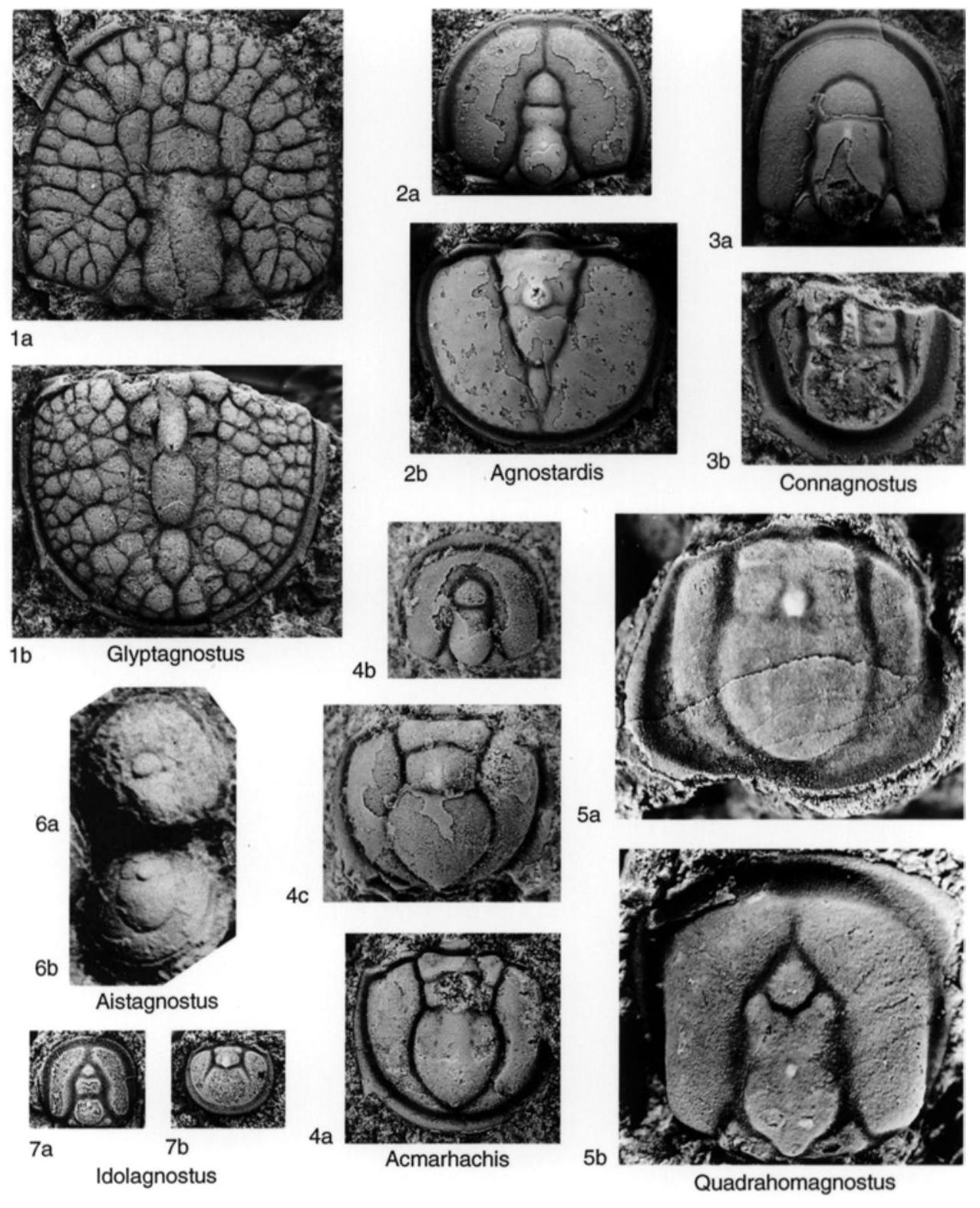Welcome to the Treatise on Invertebrate Paleontology!
Please enter a genera name to retrieve more information.

Glyptagnostus
Classification
Phylum:
Arthropoda
Class:
Trilobita
Order:
Agnostida
Superfamily:
Agnostoidea
Family:
Agnostidae
Subfamily:
Glyptagnostinae
Formal Genus Name and Reference:
Glyptagnostus WHITEHOUSE, 1936, p. 101
Type Species:
G. toreuma, OD, =Agnostus reticulatus Angelin, 1851, p. 8, lectotype (SD WESTERGÅRD, 1947, pl. 1, fig. 2), Ar 9794, RM, Stockholm
Images
(Click to enlarge in a new window)
Fig. 222,1a,b. *G. reticulatus (ANGELIN), Upper Cambrian (Olenus Zone), Sweden (Andrarum, Skåne); a, lectotype, cephalon, RM Ar 9794, × 8; b, paralectotype, pygidium of ANGELIN (1851), RM Ar 9796, ×8 (new).
Synonyms
Barrandagnostu
Geographic Distribution
Cosmopolitan
Age Range
Beginning Stage in Treatise Usage:
lower Upper Cambrian (upper Mindyallan)
Beginning International Stage:
Paibian
Fraction Up In Beginning Stage:
0
Beginning Date:
497
Ending Stage in Treatise Usage:
lower Upper Cambrian (lower Idamean)
Ending International Stage:
Jiangshanian
Fraction Up In Ending Stage:
10
Ending Date:
493.88
Description
Of low convexity, both cephalon and pygidium strongly scrobiculate. Glabella with anterior lobe subpentagonal to subquadrate, commonly with median sulcus, F3 straight or bent forwards. Posterior lobe with very well-developed F1 furrow and with lateral portions of M2 separated from the midmost glabella by longitudinal (exsag.) furrows. Glabellar node located from midway between F1 and F2 to level of F2. Basal lobes large, triangular. Pygidial axis constricted across M2, M1 trilobate, F1 bent forward, M2 trilobate, axial node extending well on to posterior lobe.
References
Museum or Author Information
Classification
Phylum:
Arthropoda
Class:
Trilobita
Order:
Agnostida
Superfamily:
Agnostoidea
Family:
Agnostidae
Subfamily:
Glyptagnostinae
Formal Genus Name and Reference:
Glyptagnostus WHITEHOUSE, 1936, p. 101
Type Species:
G. toreuma, OD, =Agnostus reticulatus Angelin, 1851, p. 8, lectotype (SD WESTERGÅRD, 1947, pl. 1, fig. 2), Ar 9794, RM, Stockholm
Images
(Click to enlarge in a new window)
Fig. 222,1a,b. *G. reticulatus (ANGELIN), Upper Cambrian (Olenus Zone), Sweden (Andrarum, Skåne); a, lectotype, cephalon, RM Ar 9794, × 8; b, paralectotype, pygidium of ANGELIN (1851), RM Ar 9796, ×8 (new).
Synonyms
Barrandagnostu
Geographic Distribution
Cosmopolitan
Age Range
Beginning Stage in Treatise Usage:
lower Upper Cambrian (upper Mindyallan)
Beginning International Stage:
Paibian
Fraction Up In Beginning Stage:
0
Beginning Date:
497
Ending Stage in Treatise Usage:
lower Upper Cambrian (lower Idamean)
Ending International Stage:
Jiangshanian
Fraction Up In Ending Stage:
10
Ending Date:
493.88
Description
Of low convexity, both cephalon and pygidium strongly scrobiculate. Glabella with anterior lobe subpentagonal to subquadrate, commonly with median sulcus, F3 straight or bent forwards. Posterior lobe with very well-developed F1 furrow and with lateral portions of M2 separated from the midmost glabella by longitudinal (exsag.) furrows. Glabellar node located from midway between F1 and F2 to level of F2. Basal lobes large, triangular. Pygidial axis constricted across M2, M1 trilobate, F1 bent forward, M2 trilobate, axial node extending well on to posterior lobe.
